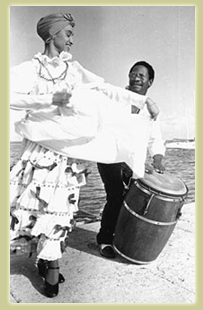Culture: Portrait of Our Soul
A Dance From The Past
A Dance From The Past
 Mention the word “Bamboula” and few Virgin Islanders today will know what you’re talking about. We once did. The Bamboula was an African-derived dance, music and drumming tradition that flourished in the Virgin Islands prior to the 20th century; it is cousin to the “Bomba,” an African-inspired folkloric tradition that still thrives in Puerto Rico.
Mention the word “Bamboula” and few Virgin Islanders today will know what you’re talking about. We once did. The Bamboula was an African-derived dance, music and drumming tradition that flourished in the Virgin Islands prior to the 20th century; it is cousin to the “Bomba,” an African-inspired folkloric tradition that still thrives in Puerto Rico.
The drummer and dancer in these photos were members of a Puerto Rican dance company that visited St. Croix during the late eighties. I photographed them near the Christiansted wharf. While performing, the drummer chanted praises of the Bamboula.
This tradition “can be traced” to the Congo River region of Africa writes Margot Lieth-Phillip, Ph.D, in the preface of Zoop, Zoop, Zoop: Traditional Music and folklore of St. Croix, St. Thomas and St. John. Some researchers speculate the Bamboula might have also made its way to New Orleans.
I was in my twenties when I first heard about the Bamboula. I “discovered” it while reading Redemption, a book by well-known Crucian author and political activist Mario Moorehead. Moorehead credits the Bamboula for adding spice and zest to the Quadrille, a dance of European origin that was introduced in the 18th and 19th century. Unlike the Bamboula, the Quadrille is still performed in the Virgin Islands today on a regular basis.
But the Bamboula was not merely a form of entertainment. In the book Old Time Masquerading in the Virgin Islands by Robert Nichols, a local Virgin Islander named Chas Emmanuel says: “the bamboula functioned as the eyes and the ears of the society and served both as a local tabloid and scandal sheet rolled into one.”
What became of this art form? Nichols says “strong social pressure” from the colonial establishment led to the decline of the Bamboula as a folkloric expression.